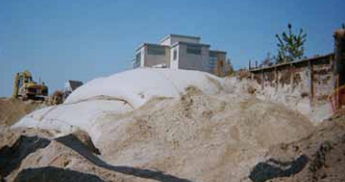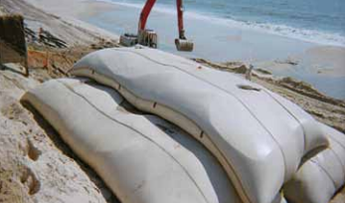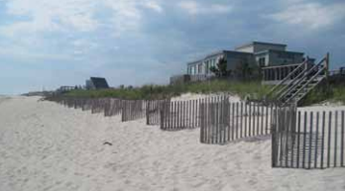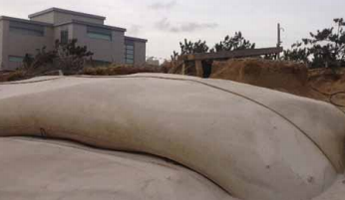
During a Nor’easter in March of 2010, heavy surf and high winds devastated the dune system protecting beach front homes, near the Hampton’s, on the twin forks of Long Island, New York. With the dunes gone, there was nothing left to protect the beachfront properties from future storms.
Instead of doing a “sand push” along the beach, or trucking in sand to rebuild the dunes, Maccaferri was approached to offer an alternative long term solution.
The steel sheeting shown in the top right image was a temporary solution after an earlier storm; however, the US Army Corp of Engineers mandated that it was to be removed.
The MacTubes® were installed as the only means of defense against future storms.
LONG-TERM SCOUR PROTECTION

Using Maccaferri’s MacTube® OS400 and a single scour protection system, a long term design solution was found. The tubes, along with the scour apron, were installed in front of the, now exposed, bulkhead and a dune core was used.
The MacScour, with a single 3 ft. anchor tube, was put in place first. The MacTubes® were then unrolled on top of the scour apron.
After the tubes were installed they were covered with sand.
Later, the area was vegetated with native plants and a dune fence was put in place.
POST-CONSTRUCTION MONITORING

Based on preliminary field observations and photo documentation of the post-storm conditions, the geotextile tube structure has maintained it’s structural integrity and design characteristics with negligible sand losses from within the bag, and limited damage to the tubes due to debris.Construction was completed within two-three weeks and has since performed as designed. The photo on the right, dated August 2012 (about 2.5 years post construction), depicts that the dune has not only remained fully intact, but also naturally accreted sand along the toe. Shortly after the August 2012 photos were taken, the project area was hit by Super Storm Sandy on 29 October 2012.
Some sediment/land losses behind the tube structure were observed due to overtopping of crest height due to storm surge. However, visual inspection of the adjacent beaches to the north and south showed an average of 30 ft. of additional landward recession in areas where no tube structure was in place.

While the losses directly landward of the tube were evident, the landward extent of the erosion was less than that of neighboring shorelines. This is indicative of the tube structure acting as a wave break with increased water levels.
Due to the minor damage from debris, these structures were immediately repaired in the field following the storm’s aftermath. Maccaferri worked with a local contractor to provide fabric patches. The small voids within the tube, where rips were apparent, were filled with sand and patches were sewn into the bags. The dune structure is now rehabilitated to its original design capacity with minimal cost and labor.
DETAILS
Client: Albert Marine Construction
Main Contractor: Albert Marine Constriction
Designer: Maccaferri
Products Used: MacTube® OS400
Additional Stories from Super Storm Sandy
Staten Island Gabion Wall
Geosynthetic Responses to Super Storm Sandy
For additional project and product information, visit www.maccaferri-usa.com.












